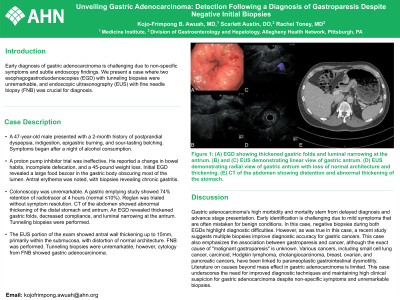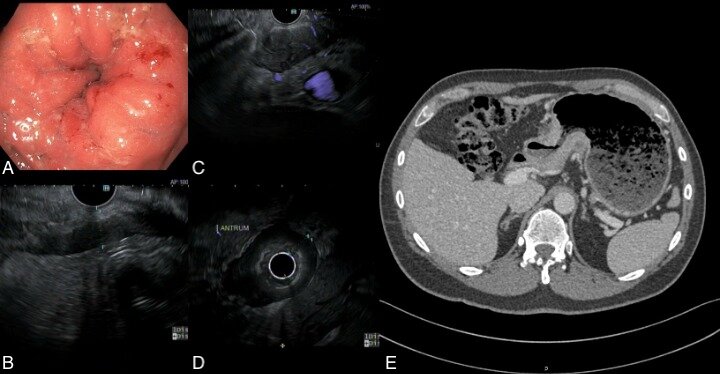Sunday Poster Session
Category: Stomach
P1651 - Unveiling Gastric Adenocarcinoma: Detection Following a Diagnosis of Gastroparesis Despite Negative Initial Biopsies
Sunday, October 27, 2024
3:30 PM - 7:00 PM ET
Location: Exhibit Hall E

Has Audio

Kojo-Frimpong B. Awuah, MD
Allegheny General Hospital
Pittsburgh, PA
Presenting Author(s)
Kojo-Frimpong B. Awuah, MD1, Scarlett Austin, DO1, Rachel Toney, MD2
1Allegheny General Hospital, Pittsburgh, PA; 2Allegheny Center for Digestive Health, Pittsburgh, PA
Introduction: Early diagnosis of gastric adenocarcinoma is challenging due to non-specific symptoms and subtle endoscopy findings. We present a case where two esophagogastroduodenoscopies (EGD) with tunneling biopsies were unremarkable, and endoscopic ultrasonography (EUS) with fine needle biopsy (FNB) was crucial for diagnosis.
Case Description/Methods: A 47-year-old male presented with a 2-month history of postprandial dyspepsia, indigestion, epigastric burning, and sour-tasting belching. Symptoms began after a night of alcohol consumption. A proton pump inhibitor trial was ineffective. He reported a change in bowel habits, incomplete defecation, and a 45-pound weight loss. Initial EGD revealed a large food bezoar in the gastric body obscuring most of the lumen. Antral erythema was noted, with biopsies revealing chronic gastritis. Colonoscopy was unremarkable. A gastric emptying study showed 74% retention of radiotracer at 4 hours (normal ≤10%). Reglan was trialed without symptom resolution. CT of the abdomen showed abnormal thickening of the distal stomach and antrum. An EGD revealed thickened gastric folds, decreased compliance, and luminal narrowing at the antrum. Tunneling biopsies were performed. The EUS portion of the exam showed antral wall thickening up to 15mm, primarily within the submucosa, with distortion of normal architecture. FNB was performed. Tunneling biopsies were unremarkable; however, cytology from FNB showed gastric adenocarcinoma.
Discussion: Gastric adenocarcinoma's high morbidity and mortality stem from delayed diagnosis and advance stage presentation. Early identification is challenging due to mild symptoms that are often mistaken for benign conditions. In this case, negative biopsies during both EGDs highlight diagnostic difficulties. However, as was true in this case, a recent study suggests multiple biopsies improve diagnostic accuracy for gastric cancers. This case also emphasizes the association between gastroparesis and cancer, although the exact cause of "malignant gastroparesis" is unknown. Various cancers, including small cell lung cancer, carcinoid, Hodgkin lymphoma, cholangiocarcinoma, breast, ovarian, and pancreatic cancers, have been linked to paraneoplastic gastrointestinal dysmotility. Literature on causes beyond mass effect in gastric adenocarcinoma is limited. This case underscores the need for improved diagnostic techniques and maintaining high clinical suspicion for gastric adenocarcinoma despite non-specific symptoms and unremarkable biopsies.

Disclosures:
Kojo-Frimpong B. Awuah, MD1, Scarlett Austin, DO1, Rachel Toney, MD2. P1651 - Unveiling Gastric Adenocarcinoma: Detection Following a Diagnosis of Gastroparesis Despite Negative Initial Biopsies, ACG 2024 Annual Scientific Meeting Abstracts. Philadelphia, PA: American College of Gastroenterology.
1Allegheny General Hospital, Pittsburgh, PA; 2Allegheny Center for Digestive Health, Pittsburgh, PA
Introduction: Early diagnosis of gastric adenocarcinoma is challenging due to non-specific symptoms and subtle endoscopy findings. We present a case where two esophagogastroduodenoscopies (EGD) with tunneling biopsies were unremarkable, and endoscopic ultrasonography (EUS) with fine needle biopsy (FNB) was crucial for diagnosis.
Case Description/Methods: A 47-year-old male presented with a 2-month history of postprandial dyspepsia, indigestion, epigastric burning, and sour-tasting belching. Symptoms began after a night of alcohol consumption. A proton pump inhibitor trial was ineffective. He reported a change in bowel habits, incomplete defecation, and a 45-pound weight loss. Initial EGD revealed a large food bezoar in the gastric body obscuring most of the lumen. Antral erythema was noted, with biopsies revealing chronic gastritis. Colonoscopy was unremarkable. A gastric emptying study showed 74% retention of radiotracer at 4 hours (normal ≤10%). Reglan was trialed without symptom resolution. CT of the abdomen showed abnormal thickening of the distal stomach and antrum. An EGD revealed thickened gastric folds, decreased compliance, and luminal narrowing at the antrum. Tunneling biopsies were performed. The EUS portion of the exam showed antral wall thickening up to 15mm, primarily within the submucosa, with distortion of normal architecture. FNB was performed. Tunneling biopsies were unremarkable; however, cytology from FNB showed gastric adenocarcinoma.
Discussion: Gastric adenocarcinoma's high morbidity and mortality stem from delayed diagnosis and advance stage presentation. Early identification is challenging due to mild symptoms that are often mistaken for benign conditions. In this case, negative biopsies during both EGDs highlight diagnostic difficulties. However, as was true in this case, a recent study suggests multiple biopsies improve diagnostic accuracy for gastric cancers. This case also emphasizes the association between gastroparesis and cancer, although the exact cause of "malignant gastroparesis" is unknown. Various cancers, including small cell lung cancer, carcinoid, Hodgkin lymphoma, cholangiocarcinoma, breast, ovarian, and pancreatic cancers, have been linked to paraneoplastic gastrointestinal dysmotility. Literature on causes beyond mass effect in gastric adenocarcinoma is limited. This case underscores the need for improved diagnostic techniques and maintaining high clinical suspicion for gastric adenocarcinoma despite non-specific symptoms and unremarkable biopsies.

Figure: Figure 1: (A) EGD showing thickened gastric folds and luminal narrowing at the antrum.
(B) and (C) EUS demonstrating linear view of gastric antrum.
(D) EUS demonstrating radial view of gastric antrum with loss of normal architecture and thickening.
(E) CT of the abdomen showing distention and abnormal thickening of the stomach.
(B) and (C) EUS demonstrating linear view of gastric antrum.
(D) EUS demonstrating radial view of gastric antrum with loss of normal architecture and thickening.
(E) CT of the abdomen showing distention and abnormal thickening of the stomach.
Disclosures:
Kojo-Frimpong Awuah indicated no relevant financial relationships.
Scarlett Austin indicated no relevant financial relationships.
Rachel Toney indicated no relevant financial relationships.
Kojo-Frimpong B. Awuah, MD1, Scarlett Austin, DO1, Rachel Toney, MD2. P1651 - Unveiling Gastric Adenocarcinoma: Detection Following a Diagnosis of Gastroparesis Despite Negative Initial Biopsies, ACG 2024 Annual Scientific Meeting Abstracts. Philadelphia, PA: American College of Gastroenterology.
